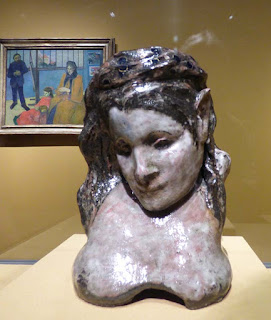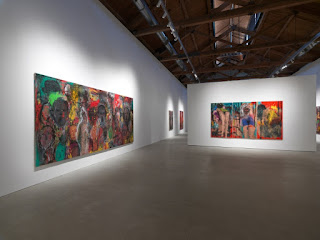Amateur Artist Chris Miller Poses as "Art Critic" for New City. New City's audience deserves to know the credentials of “Art Critic” Chris Miller. It’s a story not unlike Steve Bannon. Miller, a music retailer who began his writing career as a blogger who drove from the suburbs to the big city to experience the art scene and then blogged stories of his experience. He gained access to a platform and uses that bully pulpit to spread unfair and ill informed information. Miller is not concerned with the effect he has on accomplished artist long careers simple because he does not understand the work. With the abundant art community and a plethora of qualified art writers in Chicago, it’s sad that New City has chosen a untalented artist wannabe as an Art Critic to write for the “culture and arts” publication. But it’s hard to employ qualified writers at $15.00 a story. see attached photos of Miller’s work.
Your pitch is accepted - if not by New City, at least by me
in my blog of unpublished New City Art Reviews.
You won't get paid the $15, but everyone who cares
about the subject matter will eventually get around to
reading your opinions. And I would like to read why
you think my art is so bad. Hopefully you will have
more to discuss than credentials.
***************************************
Hey, don't give up on me here! You have expressed a valid concern: what are the qualifications for writing art criticism? Now it's time for you to continue the conversation. Requiring that a critic be a good, professional artist would disqualify most of the iconic names in art criticism from John Ruskin to Clive Bell to Clement Greenberg to Jerry Saltz. That's OK with me -- perhaps their reputations are undeserved. But to make your case, you might at least demonstrate the inadequacy of a specific art review that they, or I, have written.
Or... maybe you're not really interested
in the qualifications of an art critic. Are you an artist who feels poorly served by one
of my reviews?
I better respond before I get another email from you. I guess spoiled husbands have a lot of time on their hands unlike the artist you review whose livelihoods are derived through art. Something you need to understand...this is not a conversation, it’s a one sided narrative...like a published art review. Don’t worry about the $15, however I have failed to find the pitch on your blog, therefore I guess your honesty is in question too. It’s understandable that it would never be published by New City so you’ll have to look for it somewhere else. As to why I think your art is bad, all you have to do is go to a high school art class and find that answer. But I’d be interested in seeing an artist CV/Resume if you think you are a professional artist. I realize you don’t like discussing credentials given you did not defend or add to your “art critic” farce. Chris, you are no John Ruskin, you are no Clive Bell, you are no Clement Greenberg, and you are no Jerry Saltz and the thought that you think you are in this club is laughable. If you think art reviews are accurate and unquestionable you should really read some more about Art History. You’ve managed to worm your way into the Chicago art scene and you must enjoy that press pass. It’s okay Chris, there are plenty of frauds in the art world, the problem with that is you will always have the fear of being exposed for being a hack. Oh, and your guess is wrong I am not an artist who has been "poorly served by one of your reviews". I am however someone who earns my living in art world and I'm fed up with hacks who muddy those waters. I will defend artist until my last breathe, not tear them down.
My mistake. I was thinking of your pitch as a
proposal for a story, not the story itself.
I incorrectly assumed that you were planning to
write a more thorough treatment of the
subject. I will go ahead and publish the
"pitch" that you sent me, as soon as I can
confirm your identity.
It wasn't much of a conversation - but at least it was something.
If this reader, who wishes to remain anonymous, ever gets around to explaining himself, I will append it to this post - and will do the same with responses sent by anyone else.
Likewise, for me the credentials of an art critic have no effect on the merit of what that critic has written. Obviously, the anonymous reader quoted above would strongly disagree.
Participants often feel that personal authority is at stake, so discussions about art often descend into personal attack. Especially in the anonymous world of the internet, where a troll seems to hide beneath every bridge. But we can all do better - can't we?
Unlike most art criticism, but similar to most film criticism, the question of "is this art work worth viewing ?" always lurks in the background of my writing - and evidence of the artist's success, hard work, erudition, reputation, and sincerity will not drive it away. No one is qualified to render a final judgment - but each of us has to decide where to allocate our own time and attention. Each of us has to have our own hopes and dreams.
My approach fits much better into the American artworld of sixty-five years ago -- back when a leading artist like Ben Shahn might write: "Form is the visible shape of content". If you are searching for content, take a look at the art.
In the artworld of today, a much greater emphasis is placed on context as validated by institutions and those they employ. Which might explain the above job-holder's resentment and anger.
1. Does it seem to point to something worth striving for? Because that is why I come to art.
2. What kind of human condition or issue does it seem to represent? - because that’s the most engaging topic for discussion
3. How does it relate to and compare with art history? - because this question is unavoidable -- at least for me
4. How does it relate to what has been written about it by the artist or others? - because I am fascinated by opinions other than my own.
It's my hope that eventually other art writers
will share the above priorities.
Like myself, however, they will probably also have to come
from outside the worlds of journalism, universities.
or investment grade art galleries.
Susan Snodgrass, a prolific local writer, has provided a job description for art critics that is much more prevalent in today's artworld:
Artists are creative thinkers who challenge, expand, educate, disrupt, and revision the world in ways that others cannot. The task of the critic is not dissimilar to that of the artist. Our charge is to use the power of words to elicit, extend and mediate the dialogue, to inform and educate, to re/frame the view, to challenge the status quo. The resolve of art and artists will be tested once again with the imminent return of the culture wars reignited by Trump. Now is the time for critics to take back the discursive function of public space and re-energize the critical apparatus of alternative media and the art press. Above all, our primary mandate is to uphold the rights to free expression and free speech, including our own.
If this paragraph began with the word “politicized”, I could hardly disagree. Politicized art promulgates one side in a conflict - but I think of art as more like a harmonization of the human condition -- which is psychological, social, and environmental all at once. The more stressed the conflicts may be -- the more useful and amazing their resolution can feel. Politicized art calls for a politicized criticism that will "elicit, extend, and mediate the dialogue" that it has begun.
Critics are not commentators. Critics are not influencers. Critics are experts in a particular discipline that are able to articulate their opinions about what they encounter in that field, while also providing immense amounts of context and other sorts of arguments to back up their opinions.
I write about a fairly elite subject, which is contemporary visual art, and I write about it in a general interest publication. So I also have to provide whatever is necessary for your average reader to understand what the hell I’m talking about. Just at the level of, “What is this art? Why does it matter? How does it fit into the grander scheme of things?” Influencers and lay commentators do not have that responsibility.
Even if there is something about a piece that compels such questions, there is no correct answer to them. Personal meaning is the most important because that’s how artworks come to life in each of our lives. Driven by how the work has affected us, we’re all alone on that search. It’s the job of the art critic to stimulate thought and experience by sharing feelings, observations, and references - though that’s the job of any interlocutor in a good conversation.
The responsibility of a journalist is - or used to be - to aim at accuracy and objectivity. Objectivity is a killer, isn’t it? Apparently it’s considered impossible if not immoral in our current election cycle. Is it really any more attainable in the discussion of art? So the only serious responsibility left for the professional arts journalist is to give the editors what they want. Which would make the “Influencers and lay commentators” somewhat more sincere - for whatever that is worth
To be a critic is a very particular vocation. It’s to know your field inside and out. It’s to know what happened before, what’s happening now. To know why something is important beyond just your particular interest in it is to be able to defend all of that contextually and historically. And it’s also the ability be a fucking good writer!
"To know why something is important beyond just your particular interest in it” is to speculate on the relative status of the opinions of others. It contributes nothing to the discourses involved. That’s not art criticism - it’s social journalism.
And to know this entire “field inside and out” is impossible - even if that only refers to the academic field in which she has taught. The world of art is so vast -- even if you’re only considering the American art of our time. That’s what I learned from going to exhibitions every weekend for the past ten years. Whether it’s Puerto Rico abstract expression or Ukrainian American tapestry - there's more different kinds of things out there than one lifetime can comprehend.
These requirements are beyond challenging -- and yet Waxman is now practicing a “short form” art criticism (the “60 wrd/min art critic”) that is intentionally shoot-from-the-hip rather than based on careful deliberation and research. The critic declares that she will only spend twenty minutes on each review. Occasionally that review is judgmental rather than merely descriptive. That’s what I would call irresponsible - even if the artists are fully aware of the circumstances.
For what is the New Art Criticism? It is simply the attempt to apply to current art the same standards which we apply to ancient art, to disengage from the enormous stream of picture-producers the one or two contemporary masters who are worthy to be named beside the ancients, the one or two promising talents that may some day deserve the same praise ; to refuse steadfastly to confound the very good with the pretty bad, and to take mediocrity at its own estimate.... Dugald MacColl, 1893



















































